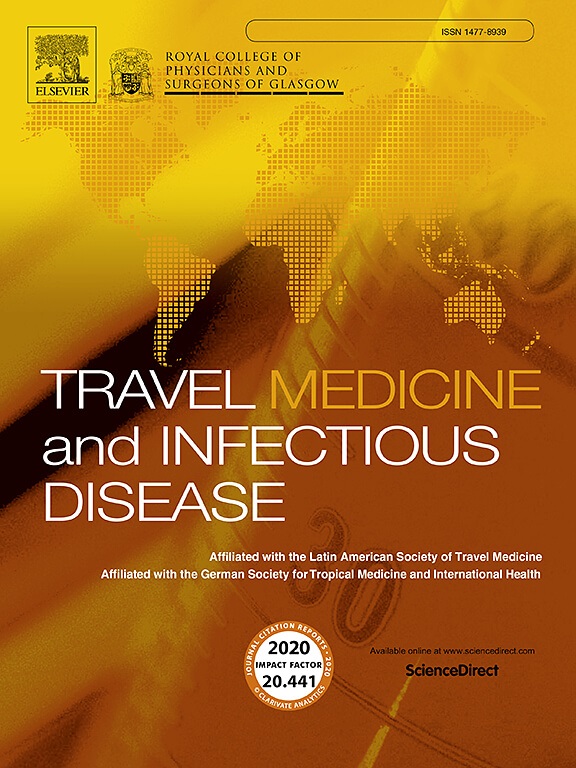模拟国际旅行感染脆弱地阿米巴的风险:与十二指肠贾第鞭毛虫数据的比较。
IF 4.7
3区 医学
Q1 INFECTIOUS DISEASES
引用次数: 0
摘要
背景:脆弱双阿米巴(Dientamoeba fragilis, DF)肠道寄生虫在世界范围内传播,可引起长时间的胃肠道症状,但其与国际旅行的关系几乎没有研究。为了探索这种联系,我们研究了DF病例与按目的地划分的国际旅行史之间的关系,并将研究结果与十二指肠贾第虫(一种常见的旅行获得性肠道寄生虫)的数据进行了比较。方法:我们分析了赫尔辛基大都市区DF或GD感染患者的临床资料,根据其旅行史将患者分为旅行者和非旅行者。为了按目的地评估收购风险,我们设计了一个DF/GD风险评分(RS),将病例数与每个目的地的旅行数量作为分母,并从芬兰官方统计数据(OSF)中检索旅行数据。结果:DF患者报告旅行史的频率(30%)低于GD(60%)。非洲的相对相对饱和度最高(41.3),其次是亚洲和大洋洲(17.9)和美洲(11.5)。GD RSs分别为32.8、25.4和11.9。东欧和西欧、俄罗斯和波罗的海国家以及斯堪的纳维亚半岛的这两种寄生虫的相对过饱和度最低。在亚洲和大洋洲,GD RS超过DF;在其他位点,DF的RSs高于GD。结论:脆弱地阿米巴在国内外均有传播。虽然脆弱地阿米巴和十二指肠贾第虫的总体感染风险似乎都很低,但最高的相对危险度与去过(亚)热带地区有关,这两种寄生虫之间存在分区域差异。本文章由计算机程序翻译,如有差异,请以英文原文为准。
Modelling international travel as risk of acquiring Dientamoeba fragilis: Comparison to Giardia duodenalis data
Background
The intestinal parasite Dientamoeba fragilis (DF) is spread worldwide and can cause prolonged gastrointestinal symptoms, yet its link to international travel has been scarcely studied. To explore this connection, we examined the association between DF cases and international travel history by destination, comparing the findings to data on Giardia duodenalis (GD), a common travel-acquired intestinal parasite.
Methods
We analysed clinical data from patients with DF or GD infection in the Helsinki Metropolitan Area, categorizing the patients as travellers and non-travellers on the basis of their travel history. To assess acquisition risk by destination, we devised a DF/GD risk score (RS) relating case numbers to travel volumes as denominators in each destination, with travel data retrieved from the Official Statistics of Finland (OSF).
Results
Travel history was reported less frequently by patients with DF (30 %) than GD (60 %). DF had the highest RSs for Africa (41.3), followed by Asia and Oceania (17.9) and the Americas (11.5). The respective GD RSs were 32.8, 25.4, and 11.9. The lowest RSs for both parasites were recorded for Eastern and Western Europe, Russia and the Baltic countries, and Scandinavia. For Asia and Oceania, the GD RS exceeded that of DF; for the other sites, DF had higher RSs than GD.
Conclusions
Dientamoeba fragilis appears to be transmitted both domestically and internationally. Although the overall acquisition risk appears low, for both Dientamoeba fragilis and Giardia duodenalis, the highest RSs are linked to visits to (sub)tropical regions, with subregional differences between the two parasites.
求助全文
通过发布文献求助,成功后即可免费获取论文全文。
去求助
来源期刊

Travel Medicine and Infectious Disease
PUBLIC, ENVIRONMENTAL & OCCUPATIONAL HEALTH-INFECTIOUS DISEASES
CiteScore
19.40
自引率
1.70%
发文量
211
审稿时长
49 days
期刊介绍:
Travel Medicine and Infectious Disease
Publication Scope:
Publishes original papers, reviews, and consensus papers
Primary theme: infectious disease in the context of travel medicine
Focus Areas:
Epidemiology and surveillance of travel-related illness
Prevention and treatment of travel-associated infections
Malaria prevention and treatment
Travellers' diarrhoea
Infections associated with mass gatherings
Migration-related infections
Vaccines and vaccine-preventable disease
Global policy/regulations for disease prevention and control
Practical clinical issues for travel and tropical medicine practitioners
Coverage:
Addresses areas of controversy and debate in travel medicine
Aims to inform guidelines and policy pertinent to travel medicine and the prevention of infectious disease
Publication Features:
Offers a fast peer-review process
Provides early online publication of accepted manuscripts
Aims to publish cutting-edge papers
 求助内容:
求助内容: 应助结果提醒方式:
应助结果提醒方式:


